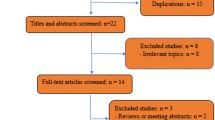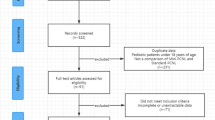Abstract
Purpose
To compare the efficacy and safety of mini-percutaneous nephrolithotomy (mini-PCNL) versus retrograde intrarenal surgery (RIRS) for treatment of 10–20 mm lower pole renal stones.
Methods
A comprehensive literature search of PubMed, Scopus, the Cochrane Library, and Web of Science was conducted to identify all studies comparing mini-PCNL and RIRS for 10–20 mm lower pole renal stones before March 2019. Article selection proceeded according to the search strategy based on the Preferred Reporting Items for Systematic Reviews and Meta-analyses (PRISMA) guidelines. The meta-analysis was performed with the R program version 3.5.1.
Results
A total of five studies were included (two randomized controlled trials and three case-controlled trials) with a total of 587 patients included. The success rate was significantly higher in the mini-PCNL group (OR 1.67; 95% CI p = 0.05). Operative and fluoroscopy times were similar for both groups (MD 2.45; 95% CI p = 0.87 and MD 2.11; 95% CI p = 0.09, respectively). Concerning the hospital stay and overall complication rates, there were no differences between the two procedures (MD 41.94; 95% CI p = 0.18 and OR 1.76; 95% CI p = 0.11).
Conclusion
Our analysis showed that both procedures are safe for treatment of 10–20 mm lower pole renal stones with similar complication rates, operative times, fluoroscopy times and length of hospital stay, but mini-PCNL was significantly superior in effectiveness with a higher success rate. Based on these results, mini-PCNL may be included in the guidelines as a safe and effective alternative treatment for 10–20 mm lower pole stones.



Similar content being viewed by others
References
Trinchieri ACG et al (2003) Epidemiology. Stone disease. Health Publications, Paris
Stamatelou KK, Francis ME et al (2003) Time trends in reported prevalence of kidney stones in the United States. Kidney Int 63:1817–1823. https://doi.org/10.1046/j.1523-1755.2003.00917.x
Türk C, Neisius A, Petřík A, Seitz C, Thomas K, Skolarikos (2018) EAU guidelines on urolithiasis. In: European Association of Urology guidelines, 2018 edn. The European Association of Urology Guidelines Office, Arnhem, The Netherlands. http://uroweb.org/guideline/urolithiasis/LK-UrolithiasisUroweb%7C
Perlmutter AE, Talug C, Tarry WF, Zaslau S, Mohseni H, Kandzari SJ (2008) Impact of stone location on success rates of endoscopic lithotripsy for nephrolithiasis. Urology 71(2):214–217. https://doi.org/10.1016/j.urology.2007.09.023
Pearle MS, Lingeman JE, Leveillee R et al (2018) Prospective randomized trial comparing shock wave lithotripsy and ureteroscopy for lower pole caliceal calculi 1 cm or less. J Urol 179(5S):S69. https://doi.org/10.1016/j.juro.2008.03.140
Srisubat A, Potisat S, Lojanapiwat B, Setthawong V, Laopaiboon M (2014) Extracorporeal shock wave lithotripsy (ESWL) versus percutaneous nephrolithotomy (PCNL) or retrograde intrarenal surgery (RIRS) for kidney stones. Cochrane Database Syst Rev. https://doi.org/10.1002/14651858.CD007044.pub3
Sam Z, Nasehi A, Basiri A et al (2004) PCNL in the management of lower pole caliceal calculi. Urol J 1(3):174–176
Jackman SV, Docimo SG, Cadeddu JA, Bishoff JT, Kavoussi LR, Jarrett TW (1998) The “mini-perc” technique: a less invasive alternative to percutaneous nephrolithotomy. World J Urol 16(6):371–374. https://doi.org/10.1007/s003450050083
Monga M, Oglevie S (2000) Minipercutaneous nephrolithotomy. J Endourol 14(5):419–421. https://doi.org/10.1089/end.2000.14.419
Kokov D, Manka L, Beck A et al (2019) Only size matters in stone patients: computed tomography controlled stone-free rates after mini-percutaneous nephrolithotomy. Urol Int. https://doi.org/10.1159/000497442
Zhang W, Zhou T, Wu T et al (2015) Retrograde intrarenal surgery versus percutaneous nephrolithotomy versus extracorporeal shock wave lithotripsy for treatment of lower pole renal stones: a meta-analysis and systematic review. J Endourol 29(7):745–759
Ruhayel Y, Tepeler A, Dabestani S et al (2017) Tract sizes in miniaturized percutaneous nephrolithotomy: a systematic review from the European Association of Urology Urolithiasis Guidelines Panel. Eur Urol 72:220–235. https://doi.org/10.1016/j.eururo.2017.01.046
Phillips B, Ball C, Sackett D, Banenoch D, Straus S, Haynes B (2009) Oxford centre for evidence-based medicine—levels of evidence. Cent. Evidence-Based Med. http://www.cebm.net/index.aspx?o=1025
Higgins JPT, Green S (eds) (2011) Cochrane handbook for systematic reviews of interventions, Version 5.1.0. The Cochrane Collaboration. www.cochrane-handbook.org. Updated Mar 2011
Fayad AS, Elsheikh MG, Ghoneima W (2017) Tubeless mini-percutaneous nephrolithotomy versus retrograde intrarenal surgery for lower calyceal stones of ≤ 2 cm: a prospective randomised controlled study. Arab J Urol 15(1):36–41. https://doi.org/10.1016/j.aju.2016.10.002
Kumar A, Kumar N, Vasudeva P, Kumar Jha S, Kumar R, Singh H (2015) A prospective, randomized comparison of shock wave lithotripsy, retrograde intrarenal surgery and miniperc for treatment of 1–2 cm radiolucent lower calyceal renal calculi: a single center experience. J Urol 193(1):160–164. https://doi.org/10.1016/j.juro.2014.07.088
Li M-M, Yang H-M, Qi H-G, Weng G-B, Liu X-M (2018) Retrograde intrarenal surgery vs miniaturized percutaneous nephrolithotomy to treat lower pole renal stones 15–25 cm in diameter. World J Clin Cases 6(15):931–935. https://doi.org/10.12998/wjcc.v6.i15.931
Akbulut F, Kucuktopcu O, Kandemir E et al (2016) Comparison of flexible ureterorenoscopy and mini-percutaneous nephrolithotomy in treatment of lower calyceal stones smaller than 2 cm. Ren Fail 38(1):163–167. https://doi.org/10.3109/0886022X.2015.1128792
Kirac M, Bozkurt ÖF, Tunc L, Guneri C, Unsal A, Biri H (2013) Comparison of retrograde intrarenal surgery and minipercutaneous nephrolithotomy in management of lower-pole renal stones with a diameter of smaller than 15 mm. Urol Res 41(3):241–246. https://doi.org/10.1007/s00240-013-0552-0
Yuri P, Hariwibowo R, Soeroharjo I et al (2018) Meta-analysis of optimal management of lower pole stone of 10–20 mm: flexible ureteroscopy (FURS) versus extracorporeal shock wave lithotripsy (ESWL) versus percutaneous nephrolithotomy (PCNL). Acta Med Indones 50(1):18
de la Rosette J, Assimos D, Desai M et al (2011) The clinical research office of the endourological society percutaneous nephrolithotomy global study: indications, complications, and outcomes in 5803 patients. J Endourol 25(1):11–17. https://doi.org/10.1089/end.2010.0424
Davis NF, Quinlan MR, Poyet C, Lawrentschuk N, Bolton DM, Webb D et al (2018) Miniaturised percutaneous nephrolithotomy versus flexible ureteropyeloscopy: a systematic review and meta-analysis comparing clinical efficacy and safety profile. World J Urol 36:1127–1138. https://doi.org/10.1007/s00345-018-2230-x
Luo D-Y, Gao X-S, Chen Y-T et al (2017) Different tract sizes of miniaturized percutaneous nephrolithotomy versus retrograde intrarenal surgery: a systematic review and meta-analysis. J Endourol 31(11):1101–1110. https://doi.org/10.1089/end.2017.0547
Aldoukhi AH, Black KM, Ghani KR (2019) Emerging laser techniques for the management of stones. Urol Clin N Am 46(2):193–205
Albala DM, Assimos DG, Clayman RV et al (2001) Lower pole I: a prospective randomized trial of extracorporeal shock wave lithotripsy and percutaneous nephrostolithotomy for lower pole nephrolithiasis—initial results. J Urol 166(6):2072–2080
Öbek C, Önal B, Kantay K et al (2001) The efficacy of extracorporeal shock wave lithotripsy for isolated lower pole calculi compared with isolated middle and upper caliceal calculi. J Urol 166(6):2081–2085. https://doi.org/10.1016/S0022-5347(05)65509-7
Sampaio FJB, Aragao AHM (1994) Limitations of extracorporeal shockwave lithotripsy for lower caliceal stones: anatomic insight. J Endourol 8(4):241–247. https://doi.org/10.1089/end.1994.8.241
Inoue T, Murota T, Okada S et al (2015) Influence of pelvicaliceal anatomy on stone clearance after flexible ureteroscopy and holmium laser lithotripsy for large renal stones. J Endourol 29(9):998–1005. https://doi.org/10.1089/end.2015.0071
Jiang H, Yu Z, Chen L et al (2017) Minimally invasive percutaneous nephrolithotomy versus retrograde intrarenal surgery for upper urinary stones: a systematic review and meta-analysis. Biomed Res Int. https://doi.org/10.1155/2017/2035851
Author information
Authors and Affiliations
Contributions
JDC: Protocol/project development, data collection or management, data analysis, manuscript writing/editing; BOM: Protocol/project development, data collection or management, data analysis, manuscript writing/editing; JET: Data collection or management; FV: Manuscript writing/editing; HMS: Manuscript writing/editing; EAR: Statistical analysis; EL: Statistical analysis.
Corresponding author
Ethics declarations
Conflict of interest
The authors declare that they have no conflicts of interest.
Statement of human and animal rights
This article does not contain any studies with human participants or animals performed by any of the authors.
Informed consent
For this type of study, formal consent is not required.
Additional information
Publisher's Note
Springer Nature remains neutral with regard to jurisdictional claims in published maps and institutional affiliations.
Rights and permissions
About this article
Cite this article
Cabrera, J.D., Manzo, B.O., Torres, J.E. et al. Mini-percutaneous nephrolithotomy versus retrograde intrarenal surgery for the treatment of 10–20 mm lower pole renal stones: a systematic review and meta-analysis. World J Urol 38, 2621–2628 (2020). https://doi.org/10.1007/s00345-019-03043-8
Received:
Accepted:
Published:
Issue Date:
DOI: https://doi.org/10.1007/s00345-019-03043-8




